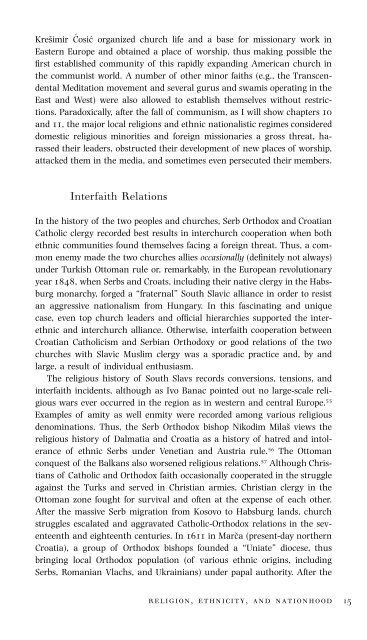Balkan Idols: Religion and Nationalism in Yugoslav States
Balkan Idols: Religion and Nationalism in Yugoslav States
Balkan Idols: Religion and Nationalism in Yugoslav States
Create successful ePaper yourself
Turn your PDF publications into a flip-book with our unique Google optimized e-Paper software.
Kresˇimir Ćosić organized church life <strong>and</strong> a base for missionary work <strong>in</strong><br />
Eastern Europe <strong>and</strong> obta<strong>in</strong>ed a place of worship, thus mak<strong>in</strong>g possible the<br />
first established community of this rapidly exp<strong>and</strong><strong>in</strong>g American church <strong>in</strong><br />
the communist world. A number of other m<strong>in</strong>or faiths (e.g., the Transcendental<br />
Meditation movement <strong>and</strong> several gurus <strong>and</strong> swamis operat<strong>in</strong>g <strong>in</strong> the<br />
East <strong>and</strong> West) were also allowed to establish themselves without restrictions.<br />
Paradoxically, after the fall of communism, as I will show chapters 10<br />
<strong>and</strong> 11, the major local religions <strong>and</strong> ethnic nationalistic regimes considered<br />
domestic religious m<strong>in</strong>orities <strong>and</strong> foreign missionaries a gross threat, harassed<br />
their leaders, obstructed their development of new places of worship,<br />
attacked them <strong>in</strong> the media, <strong>and</strong> sometimes even persecuted their members.<br />
Interfaith Relations<br />
In the history of the two peoples <strong>and</strong> churches, Serb Orthodox <strong>and</strong> Croatian<br />
Catholic clergy recorded best results <strong>in</strong> <strong>in</strong>terchurch cooperation when both<br />
ethnic communities found themselves fac<strong>in</strong>g a foreign threat. Thus, a common<br />
enemy made the two churches allies occasionally (def<strong>in</strong>itely not always)<br />
under Turkish Ottoman rule or, remarkably, <strong>in</strong> the European revolutionary<br />
year 1848, when Serbs <strong>and</strong> Croats, <strong>in</strong>clud<strong>in</strong>g their native clergy <strong>in</strong> the Habsburg<br />
monarchy, forged a “fraternal” South Slavic alliance <strong>in</strong> order to resist<br />
an aggressive nationalism from Hungary. In this fasc<strong>in</strong>at<strong>in</strong>g <strong>and</strong> unique<br />
case, even top church leaders <strong>and</strong> official hierarchies supported the <strong>in</strong>terethnic<br />
<strong>and</strong> <strong>in</strong>terchurch alliance. Otherwise, <strong>in</strong>terfaith cooperation between<br />
Croatian Catholicism <strong>and</strong> Serbian Orthodoxy or good relations of the two<br />
churches with Slavic Muslim clergy was a sporadic practice <strong>and</strong>, by <strong>and</strong><br />
large, a result of <strong>in</strong>dividual enthusiasm.<br />
The religious history of South Slavs records conversions, tensions, <strong>and</strong><br />
<strong>in</strong>terfaith <strong>in</strong>cidents, although as Ivo Banac po<strong>in</strong>ted out no large-scale religious<br />
wars ever occurred <strong>in</strong> the region as <strong>in</strong> western <strong>and</strong> central Europe. 55<br />
Examples of amity as well enmity were recorded among various religious<br />
denom<strong>in</strong>ations. Thus, the Serb Orthodox bishop Nikodim Milasˇ views the<br />
religious history of Dalmatia <strong>and</strong> Croatia as a history of hatred <strong>and</strong> <strong>in</strong>tolerance<br />
of ethnic Serbs under Venetian <strong>and</strong> Austria rule. 56 The Ottoman<br />
conquest of the <strong>Balkan</strong>s also worsened religious relations. 57 Although Christians<br />
of Catholic <strong>and</strong> Orthodox faith occasionally cooperated <strong>in</strong> the struggle<br />
aga<strong>in</strong>st the Turks <strong>and</strong> served <strong>in</strong> Christian armies, Christian clergy <strong>in</strong> the<br />
Ottoman zone fought for survival <strong>and</strong> often at the expense of each other.<br />
After the massive Serb migration from Kosovo to Habsburg l<strong>and</strong>s, church<br />
struggles escalated <strong>and</strong> aggravated Catholic-Orthodox relations <strong>in</strong> the seventeenth<br />
<strong>and</strong> eighteenth centuries. In 1611 <strong>in</strong> Marča (present-day northern<br />
Croatia), a group of Orthodox bishops founded a “Uniate” diocese, thus<br />
br<strong>in</strong>g<strong>in</strong>g local Orthodox population (of various ethnic orig<strong>in</strong>s, <strong>in</strong>clud<strong>in</strong>g<br />
Serbs, Romanian Vlachs, <strong>and</strong> Ukra<strong>in</strong>ians) under papal authority. After the<br />
religion, ethnicity, <strong>and</strong> nationhood 15


